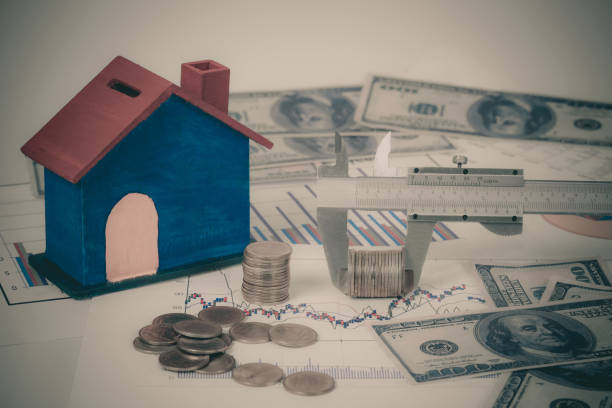The US housing market has experienced significant fluctuations over recent years, largely influenced by changing economic conditions. A key factor currently affecting the market is the rise in interest rates, which has had broad consequences for both buyers and sellers. As mortgage rates increase, the costs of borrowing rise, influencing housing demand, affordability, and home
The US housing market has experienced significant fluctuations over recent years, largely influenced by changing economic conditions. A key factor currently affecting the market is the rise in interest rates, which has had broad consequences for both buyers and sellers. As mortgage rates increase, the costs of borrowing rise, influencing housing demand, affordability, and home prices. This article delves into how rising interest rates are reshaping the housing market, examining the consequences on affordability, buyer behavior, and housing supply, as well as the broader economic implications.
Understanding Interest Rates and the US Housing Market
Interest rates represent the cost of borrowing money, and they are influenced by various economic factors, including Federal Reserve policies, inflation rates, and overall economic conditions. Mortgage rates, which are directly linked to interest rates, play a vital role in determining monthly payments for homebuyers. When interest rates rise, borrowing becomes more expensive, and mortgage rates climb, which can affect housing demand and the accessibility of homeownership.
Why Are Interest Rates Rising?
The Federal Reserve (Fed) often raises interest rates as a measure to curb inflation. When inflation is high, the purchasing power of currency decreases, which can lead to an overheated economy. By raising interest rates, the Fed aims to moderate spending and encourage saving, which helps reduce inflationary pressure. Recently, as the US economy rebounded post-pandemic, inflation soared due to increased consumer spending, labor shortages, and supply chain issues. To combat this inflation, the Fed has implemented a series of rate hikes, leading to a noticeable increase in mortgage rates.
The Impact of Rising Interest Rates on Housing Affordability
Increasing Mortgage Costs
One of the most immediate impacts of rising interest rates is an increase in mortgage costs. Higher mortgage rates translate directly into higher monthly payments for new buyers, which can make it difficult for some individuals to afford a home. For instance, a buyer who could afford a $400,000 house when rates were at 3% may find themselves priced out as rates approach 6%. Consequently, higher interest rates reduce the pool of potential homebuyers.
Declining Purchasing Power
With rising interest rates, buyers are often forced to adjust their price range, seeking more affordable homes. This reduction in purchasing power leads to a shift in buyer demand toward smaller or less expensive properties. For those looking to buy in high-demand areas, such as major metropolitan regions, the effects can be even more pronounced, as limited inventory means that prices may remain high despite a shrinking pool of buyers.
How Rising Interest Rates Are Affecting Home Prices

This image is taken from google.com
Stabilization of Home Prices
In recent years, housing prices have surged due to high demand and limited supply. However, as interest rates rise and demand slows, prices in many regions are beginning to stabilize. This shift is beneficial for buyers who have been priced out by extreme price increases, though it can pose challenges for sellers who may now face longer listing times or need to reduce asking prices.
Potential Decline in Some Markets
While not all markets will experience a price drop, some regions, particularly those where prices have been significantly inflated, may see corrections. For example, cities that experienced a pandemic-fueled housing boom could face a decline in prices as demand wanes. Markets where inventory is rising quickly may also experience falling prices as sellers compete to attract buyers in a slower market.
The Shift in Buyer Behavior
Increased Caution Among Buyers
Higher mortgage rates often make buyers more cautious. For first-time homebuyers, who may already face affordability challenges, the increase in rates can lead to postponing purchases. Additionally, prospective buyers who can afford to buy may hesitate, anticipating that prices could fall further if the market continues to cool. This shift in behavior is slowing the housing market as fewer transactions occur.
Rise in Cash Purchases
With rising interest rates, cash buyers may gain an advantage. Cash buyers do not rely on financing, allowing them to sidestep the impact of higher interest rates. As a result, the number of cash purchases has risen, especially among investors who are purchasing properties with the intention of renting or flipping. This trend can affect traditional buyers, who may find it harder to compete with cash offers in desirable areas.
The Supply Side: Impact on Housing Inventory
Slower New Home Construction
Builders are also affected by rising interest rates. When rates increase, the cost of financing new developments becomes more expensive, and demand for new homes may decrease as buyers shy away. Consequently, some builders are scaling back on new projects or delaying them until market conditions improve. This reduction in new home supply can further restrict inventory, impacting affordability in the long term.
Existing Homeowners Staying Put
Many existing homeowners locked in low mortgage rates in previous years, creating a disincentive to move. Selling their homes would mean forfeiting their lower-rate mortgages for new, higher-rate ones. As a result, the supply of homes from existing homeowners has decreased, which can limit options for prospective buyers and create more competition for available properties.
Economic Implications of Rising Interest Rates on the Housing Market
Reduced Spending Power in the Economy
As housing costs rise, households may have less disposable income to spend on other goods and services. This reduction in spending can affect sectors beyond real estate, such as retail and hospitality. When homeowners pay more on their mortgages, they may cut back on discretionary spending, impacting the broader economy.
Possible Slowdown in Economic Growth
The housing market is a significant driver of economic activity, influencing everything from construction jobs to furniture sales. A slowdown in the housing market can lead to a broader economic slowdown, as reduced demand for homes impacts multiple sectors. While the Fed’s rate hikes aim to manage inflation, the trade-off is a potential slowdown in economic growth, particularly if consumer spending declines across multiple industries.
Future Outlook for the US Housing Market
The future of the US housing market largely depends on the trajectory of interest rates. If inflation moderates and the Fed slows down its rate hikes, we may see a stabilization in mortgage rates. This could help steady home prices and ease affordability issues. However, if rates continue to rise, we could witness further slowdowns in buyer demand, potential price corrections in overheated markets, and a more prolonged impact on economic growth.
Analysis Table: Key Impacts of Rising Interest Rates on the US Housing Market
| Factor | Impact |
|---|---|
| Mortgage Costs | Higher monthly payments make homeownership less affordable, reducing demand. |
| Purchasing Power | Reduced budgets lead buyers to seek less expensive homes, affecting demand for mid- to high-end homes. |
| Home Prices | Prices stabilize or decline in response to slower demand. |
| Buyer Behavior | Increased caution and fewer transactions, with more cash buyers entering the market. |
| Housing Supply | Slower new construction and limited listings from existing homeowners contribute to low inventory. |
| Economic Implications | Reduced disposable income and potential economic slowdown in sectors beyond housing. |
Comparative Table: Effects of Rising vs. Low Interest Rates on Housing
| Aspect | Rising Interest Rates | Low Interest Rates |
|---|---|---|
| Mortgage Affordability | Higher mortgage costs; decreased affordability | Lower mortgage costs; increased affordability |
| Buyer Demand | Decreased demand; buyers face affordability issues | Increased demand; buyers more active in the market |
| Home Prices | Prices may stabilize or fall | Prices often rise due to strong demand |
| New Home Construction | Slower due to higher financing costs | Faster; builders more inclined to take on new projects |
| Inventory Levels | Limited as fewer homeowners move or list properties | Higher as sellers capitalize on strong demand |
| Economic Growth | Potential slowdown as spending shifts | Stimulated growth with high housing-related spending |
Conclusion
Rising interest rates have a substantial impact on the US housing market, influencing everything from mortgage affordability to buyer demand and housing supply. As the Fed seeks to control inflation, higher rates may continue to temper the market, affecting both current and prospective homeowners. While challenging for buyers, these adjustments may lead to a more balanced market and moderate the extreme price growth seen in recent years. Homebuyers, sellers, and investors will need to stay attuned to interest rate trends, as these will shape the housing market’s trajectory in the coming months.
















